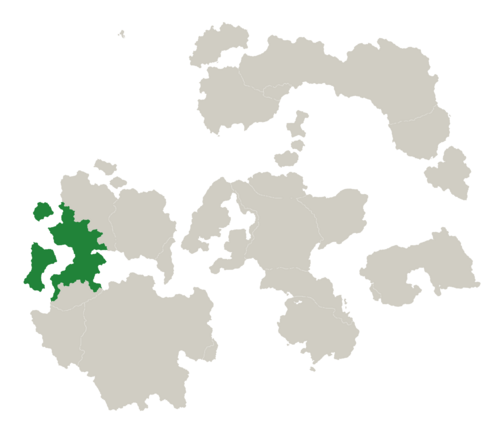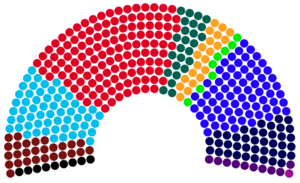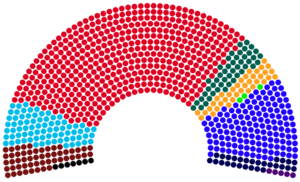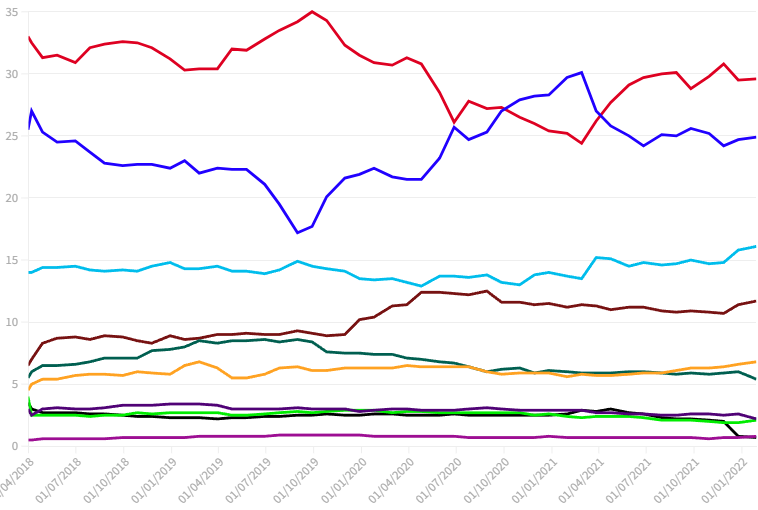Esthursia
This article is incomplete because it is pending further input from participants, or it is a work-in-progress by one author. Please comment on this article's talk page to share your input, comments and questions. Note: To contribute to this article, you may need to seek help from the author(s) of this page. |
Union of Esthursia Undebau yr Esddŵrsu | |
|---|---|
| Motto: Y Cywmp Gwan The Weak Fall (Sé Wancol Forwyrd) | |
| Anthem: Progress and Unity | |
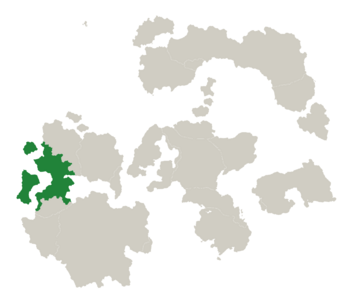 Esthursia, upon the west of Auroria. | |
| Status | Federal semi-direct constitutional monarchy |
| Location | Location of the Union of Esthursia (dark green) in Auroria (grey) |
| Capital and city | Weskerby 40°15'N, 96°34'E |
| Official languages | Osynstric, Asthoric |
| Recognised national languages | Osynstric, Asthoric, Ezhoneg, Consence |
| Recognised regional languages | Late Cymbrish |
| Religion (2019) | Irreligious (72.2%), Church of Athers (23.7%), Messianism (2.0%), Other (2.1%) |
| Demonym(s) | Esthursian, Esthur/Esther |
| Government | Unitary parliamentary constitutional monarchy |
• King of the Union | Arthur VII (1949-, b. 1930) |
• Prime Minister | Harold Osborne (2015-, Social Democrat) |
• Second Minister | Jeremy Wilson (2018-, Progressive) |
• Astjórn of Asþonhelm | Ragnar Þorsenn (2017-, Asþonic Workers') |
• First Minister of Ezhonyth | Perran Trefordh (2019-, Localist) |
• First Minister of Meathere | Morwen Llawyseg (2007-, Localist) |
• First Minister of Consewent | Hedrek Lanenys (2019-, Localist) |
• Mayor of the City of Weskerby | Robert Wychavon (2019-, Progressive) |
• Mayor of the City of Brantley | Gareth Moresbond (2019-, Social Democrat) |
| Capitulation of Caerllwyfen to Classical Osþursian Empire May 11, 298 | |
• Rising of Elmcæstre, Proclamation of Asynstycg | January 15, 466 |
• Oswynht Uprising (Grand Revolution) | August 3, 1161 |
• Democracy Act of Osynstry | November 22, 1303 |
• Union of Osþursia | June 30, 1568 |
• Declaration of Chartholme | February 26, 1622 |
• Constitution of the Royal Union of Esthursia | January 31, 1957 |
| Area | |
• | 687,011 km2 (265,256 sq mi)Includes rivers and water |
| Population | |
• 2022 estimate | 141,805,639 |
• 2017 census | 137,684,112 |
• Density | 191.61/km2 (496.3/sq mi) |
| GDP (nominal) | 2022 estimate |
• Total | 6,512,384,550,000 IBU |
• Per capita | 45,924.72 IBU |
| Gini (2019) | 26.1 low |
| HDI (2019) | very high |
| Currency | Esthursian royal arian (Ꜹ) (EAN) |
| Time zone | UTC+6 (EMT) |
• Summer (DST) | UTC+7 (EST) |
| First Sunday of March - First Sunday of October | |
| Date format | dd-mm-yy |
| Driving side | left |
| Calling code | +44 |
| Internet TLD | .et |
Esthursia, officially the Union of Esthursia (Cymbrish: Undebau yr Esddŵrsu) is a developed sovereign state in the west of Auroria. It is bordered by Weskermere to the east, and Ocean of Consence to the west, with Perran's Channel passing within its borders.
Osynstry, the principal nation of Esthursia, was formed gradually between the fall of Caerllwyfen at the end of the 3rd century, through the Rising in 466, until the Classical Osþursian Empire's recognition of Asynstycg - Osynstry's direct ancestor state - in 514. Thereafter, it slowly grew - especially after the Grand Revolution of 1161 - and unified Osynstry, the fractured Cambrion and Asþorhelm under the Osynstric-led Union of Osþursia thereafter, with this Union cemented and Asynstised in 1622 into the Union of Esthursia.
Esthursia has a long history of infighting that has arguably persisted into the present day, with civil and social unrest in the western extremities continuing, albeit less than in the late 20th century. The nation is renowned for its rich culture, its varied climate which makes it a destination of tourist interest in both summer and winter, and its place in the world stage as an ardent defender of human rights worldwide.
Esthursia is a major member state of the Auronian Economic Alliance, as the previous and current Forescealcs have both pursued for the nation to solidify its place on the world stage, and has recently joined the Union of Aurorian States.
Etymology
Osynstry is derived from the Old Lower Osynstric "Asynctria" - meaning "synchronised state". This is due to the fact that from a relatively primitive time, Osynstry functioned as a federalised, or localised state under one King. Cymbria is derived from the Cymbric "cwm" - meaning valley - which reflects the terrain that the capital, Yr Gwynydd, resides within. Cymbria ceased to be a homogenous entity between the 1100s - when its final Kings began to lose grip over the external regions - and the 1500s - by which point Cymbrish had more or less lost its mutual intelligibility.
History
Cumbrian tribes (Cymraei)
The first post-Harnage nation known to modern Esthur archaeologists is dated from around 1500BCE, at which point coins denoted to "Arwaenn" - assumed to be the ruler between around 1560BCE and 1522BCE - have been found. The first hanesion (or chronicle, in modern Esthursian), the Hanesion of Gaerwynht (modern day Wynncaster, north Osynstry), has its first article from 1529BCE, towards the end of an unnamed ruler's reign (assumed to be Arwaenn). According to the Hanesion, society developed from agricultural hotspots into small towns by around 1200BCE, with the largest town developing as Caerllwyfen; with a population of about 10,000 in 1200BCE, Caerllwyfen developed as a centre for commerce and trade as well as for administration as the nation's structure consolidated. By around 1100BCE, the state was "yn gweithio'n llawn" (in full function); as such, the name Cambrion quickly became the archetype, and was used by administrators according to the Hanesion.
In 955BCE, Cambrion's new ruler, Thegdyn, had appointed himself "bywyd benadur" (life leader) - this led to the first documented resistance against the regime within the capital. The rioting quickly overwhelmed the unprepared state, which had not yet formed an armed force. The perceived weakness and ease of occupation of the capital led to the fleeing of thousands, with major towns being set up elsewhere. A transliterated article dated to speak of 944BCE in the Hanesion of Rhoswyn documents:
"A hundred towns of a hundred nations set up under the same ruler, all believing they could one day be capital. For five decades and one year, the Cambrish people lived side by side, trying to set up major towns. None succeeded, for co-operation necessitated trade, and trade necessitated a near-equal playing field. It did not take years, but months for the endeavour of rivalry to turn to blood."
By the 9th century BCE, Cambrion became gripped in a several decades' conflict whereby towns often stormed across into other towns to occupy them without reason or notice. The loss of necessary trade and some towns' failures to run the essential infrastructure led to a widespread famine, and the population is estimated to have stagnated. Some towns were laid waste, and more organised towns with more organised, hierarchical systems whereby allocation of jobs was considered rather than automatic would occupy and take over less organised towns. These "pocket regimes" spent centuries amassing armed forces to occupy their regions, however thanks to the setting up of basic merchant protections and "wanderer military inaction" conventions, the language and culture of the entire region remained mutually intelligible.
This fighting evolved into more cohesive states, who comprised of regions approximately corresponding to modern shires in size, and the cost to the population and pseudo-economies of the region was innumerable. However, following the Storming of the Denby Dales documented in almost all Hanesions of the period within a few hundred kilometres, the state of Cambrion was set up. The declaration of Cambrion was made in the winter of 511BCE, under a leader who had ruled the capital for 11 years and whose rival's state being divided in two upon his coronation led to the inevitable demise of rival regimes.
Ancient Cambrion (511BCE - 300CE)
The main town of Caerllwyfen (now Execester, north-west Osynstry) became the pseudo-capital for the new empire, however in theory (and, later, in law) the state was federalised - to the point that shires (itself from the Ancient Cambrish word, "s'yr") would often implement different forms of governance, different laws and different taxes (although later the tax system was centralised due to "tax migration".)
Until the beginning of the Common Era, Cambrion developed steadily, with an affinity for philosophy and "the study of wonderment" - one such development was the concept of basic universal rights. The concept of torture and justice was central to the development of the state - social stratification was quickly followed by the principles of each group being cemented in law. Although some barons (barwns) often refused these rights, the first uprisings usually startled the relatively unprepared militaries, who were not used to the proto-guerilla tactics rather than open warfare used by the revolutions.
By 100BCE, however, the gradual ceding of powers to new localised regimes in exchange for a lack of military violence, the breakdown of trade into set regions, the gradual settlement of Western people and the loss of transport routes on increasingly unused cross-regional areas, all led to the loss of mutual intelligibility of the Ancient Cambrish language. By 200CE, significant extra-continental influence had morphed western mainland dialects into Old Osynstric (at the time known as "Osthursic" - a demonym that gradually diverged into Anthoric, Osynstric and Esthursian). By 250CE, most urban areas along the western coast of the mainland - save for the extreme south-west - were speaking some form of this proto-Osynstric.
Cultural identity increasingly influenced the representatives of these areas - the shire leaders seized on this as a protection mechanism from the threat of internal violence, and thus became reliant on it as a result of this fear. In the year 272, Oswynht - his own name derived from the demonym of his culture - took control of the second most powerful shire of Cambrion; Pen Wynsir (now roughly Weskerby and its peninsula). Attempts to remove him by then-leader Llywelyn the Last were in vain - however Oswynht himself took over a decade to train a loyal army, after multiple mutinies and attempted assassinations.
Geography
Esthursia is situated in the temperate zone, near Ocean of Consence - from which it receives tropical winds, nicknamed the "Consent Stream" - and between two seas. Weskerby, the capital, is situated on the east peninsula, next to the eponymous Weskermere - and receives a large quantity of rain every year. Apart from the far south, all of the country receives over 500mm of rain a year, with some mountains in the south receiving a smaller amount on some years, distorting the levels and reducing their annual rainfall. The north and south borders are home to the Asthoric and Osynstric mountain ranges respectively. The entire country receives snowfall every year for at least a month, as the rolling hills of the central isthmus provide the perfect climate for snow settling and the Consent Stream weakens from ice melting in the mountains leading to cold water north and south of where it passes during the summer - meaning the temperature often varies, nicknamed the "Frozen" and "Green" winter years.
Climate
| Tregarval | ||||||||||||||||||||||||||||||||||||||||||||||||||||||||||||
|---|---|---|---|---|---|---|---|---|---|---|---|---|---|---|---|---|---|---|---|---|---|---|---|---|---|---|---|---|---|---|---|---|---|---|---|---|---|---|---|---|---|---|---|---|---|---|---|---|---|---|---|---|---|---|---|---|---|---|---|---|
| Climate chart (explanation) | ||||||||||||||||||||||||||||||||||||||||||||||||||||||||||||
| ||||||||||||||||||||||||||||||||||||||||||||||||||||||||||||
| ||||||||||||||||||||||||||||||||||||||||||||||||||||||||||||
| Brantley | ||||||||||||||||||||||||||||||||||||||||||||||||||||||||||||
|---|---|---|---|---|---|---|---|---|---|---|---|---|---|---|---|---|---|---|---|---|---|---|---|---|---|---|---|---|---|---|---|---|---|---|---|---|---|---|---|---|---|---|---|---|---|---|---|---|---|---|---|---|---|---|---|---|---|---|---|---|
| Climate chart (explanation) | ||||||||||||||||||||||||||||||||||||||||||||||||||||||||||||
| ||||||||||||||||||||||||||||||||||||||||||||||||||||||||||||
| ||||||||||||||||||||||||||||||||||||||||||||||||||||||||||||
| Thurrock | ||||||||||||||||||||||||||||||||||||||||||||||||||||||||||||
|---|---|---|---|---|---|---|---|---|---|---|---|---|---|---|---|---|---|---|---|---|---|---|---|---|---|---|---|---|---|---|---|---|---|---|---|---|---|---|---|---|---|---|---|---|---|---|---|---|---|---|---|---|---|---|---|---|---|---|---|---|
| Climate chart (explanation) | ||||||||||||||||||||||||||||||||||||||||||||||||||||||||||||
| ||||||||||||||||||||||||||||||||||||||||||||||||||||||||||||
| ||||||||||||||||||||||||||||||||||||||||||||||||||||||||||||
Regions
Osynstry (south-east) Asthorhelm (north-east) Ezhonyth (mainland, south-west) Meathere (island, south-west) Consewent (island, north-west)
Demographics
General
The population of Esthursia is around 132,000,000, as of January 2022. Population growth has remained steady since the 1990s, driving an equally steady birth rate. 96.9% of Esthursian residents were Esthurs and Esthers (those born within Esthursian borders) at the 2017 census.
Cities
Largest cities or towns in Esthursia
Institute for National Statistics (INS) census data, 2019 | |||||||||
|---|---|---|---|---|---|---|---|---|---|
| Rank | Name | Shire or District | Pop. | Rank | Name | Shire or District | Pop. | ||
| 1 | Weskerby | Brough of Weskerby | 15,894,491 | 11 | Tynwald | The South Vales | 1,426,764 | ||
| 2 | Brantley | Brough of Brantley | 11,701,115 | 12 | Gloucester | Gloucestershire | 1,288,114 | ||
| 3 | Fjármagn | Heðsteð af Fjármagn | 4,268,515 | 13 | Hewesmouth | Esthamptonshire | 1,076,429 | ||
| 4 | Esthampton | Brough of Esthampton | 3,606,273 | 14 | Ancester | Anstershire | 986,917 | ||
| 5 | Execester | Brough of Execester | 3,326,688 | 15 | Ravenscroft | City of Ravenscroft | 910,847 | ||
| 6 | Hereporth | South Hereshire | 2,479,463 | 16 | Atlington | Upper Execestershire | 858,210 | ||
| 7 | Rennezh | Bourc'h an Rennezh | 2,145,840 | 17 | Davenbrook | Davenshire | 731,343 | ||
| 8 | Yeaburn | Brough of Yeaburn | 1,984,827 | 18 | Asgarslow | Asgarshire | 698,240 | ||
| 9 | Sorren | Sorrengard | 1,871,003 | 19 | Helston | Capital District, Merthing | 692,344 | ||
| 10 | Thurrock | Welland | 1,643,840 | 20 | Mereling | Brough of Mereling | 645,634 | ||
Government
House of Barons
The Prime Minister has been Harold Osborne, a representative from the Osynstric branch of the Social Democrats, since 30 January, 2015. The House of Barons, the upper of two Houses of Berworth, has been a Social Democrat-led coalition of left-leaning parties since the 2011 Esthursian general election; the House of Ministers, the lower of the two Houses, is currently held by a Social Democratic majority following the 2018 Esthursian general election.
The House of Barons has been elected through the "open party list" system since 1934, following reforms to the then-unelected House of Barons by the then-PM Edgar Heresparn amid the general reforms by their Workers' Party governments in the early-to-mid 20th century. Attempts to reverse the reforms in 1947 by PM Mildred West of the Conservative Party were unsuccessful after a constitutional standoff between the Workers' Party-held Barons and Conservative-held House of Ministers.
Prime Ministers are, as per the Constitution of the Union of Esthursia being signed in 1957, the "party leader or independent member able to command the allegiance of the greatest coalition of representative members in the House of Barons." This Constitution also began the precedent of electing both Houses at the same time, to avoid standoffs of the nature that existed over the previous decade. This has typically left the Prime Minister working with coalitions, as no party since 1994 has successfully attained a majority in the House of Barons. Coalitions breaking up and allegiances switching to other party leaders is a rare occurrence, but has happened in the past, such as in 2011 - this usually leads to a snap election, as it did in February 2011.
The House of Barons also has the power to confirm constitutional reforms with three-quarters of members voting, however some sections require a nationwide referendum. The most recent time this has happened was 1996, whereby then Prime Minister Anthony Largan successfully passed Articles 12a through 16b through a referendum in the same year, having sought to draw an end to the Workers' Rising of the late 80s and early 90s. The House also formerly had the power to confirm Aldermen into the Council of Elders, however this power passed to the Electoral Commission in 1999. 401 members are elected to this House each general election, which is held every 4 years snap elections notwithstanding.
House of Ministers
The Deputy Prime Minister - not to be confused with Second Minister, or the typical name for the upper house coalition second-party leader - has been Brooke Alderney since 11 June, 2014. This House has been held in a fair majority - this meaning between 50 and 100 - by the Social Democrats since the 2018 general election. The Deputy PM leads the House of Ministers, and is typically from the largest party, however there have been exceptions due to coalition agreements in the past. Unlike the Prime Minister, the Deputy PM usually commands a majority in the House of Ministers - including as of January 27, 2022 - thanks to the "winner-takes-all" system currently operating for this House. There are 851 members elected to this House, although there are cross-party negotiations to reduce this to 551.
The House of Ministers is the House where most legislation begins, although the Barons reserve the power to begin writing legislation to send down to the Ministers, and they often reach a stage of "ping-pong" between the two Houses before seeking the King's Stamp.
Council of Elders
The Council of Elders is a group of 11 Aldermen, who must be fully qualified judges. They hold selective power over both Houses of Berworth, and preside over multiple roles as impartial judges:
- Upholding the Constitution, and maintaining the power to strike down laws which do not abide by the Constitution
- Prosecuting Members and Barons who act against the Constitution, the Berworth Code, or break the law
- Investigating Members and Barons' conduct
- Settling disputes between local, regional and national government entities
Until 1957, these Aldermen were elected by the House of Barons, however this power passed to the independent Electoral Commission as a feature of the Constitution.
Composition
| Party | Barony Leader | Barons | Members | |||||
|---|---|---|---|---|---|---|---|---|
| Barons | Share of total (%) | Members | Share of total (%) | |||||
| Social Democrats | Harold Osborne | 131 | 32.7% | 131 / 401
|
464 | 54.5% | 464 / 851
| |
| Conservative Party of Esthursia | Stephen Alborough | 71 | 17.7% | 71 / 401
|
141 | 16.6% | 141 / 851
| |
| Progressive Group | Jeremy Wilson | 58 | 14.5% | 58 / 401
|
77 | 9.0% | 77 / 851
| |
| Esthur People's Party | Graham Ingley | 40 | 10.0% | 40 / 401
|
28 | 3.3% | 28 / 851
| |
| Asthoric Workers' Party | Helga Járnsson | 27 | 6.7% | 27 / 401
|
53 | 6.2% | 53 / 851
| |
| The Localist Group | Morwen Llethan | 24 | 6.0% | 24 / 401
|
47 | 5.5% | 47 / 851
| |
| Middle Party | John Frampton | 21 | 5.2% | 21 / 401
|
37 | 4.3% | 37 / 851
| |
The House of Barons and Members containing different electoral systems has often led to abnormal results. This often causes what is known colloquially a "minor-majority", whereby the governing party leads a coalition in the House of Barons, but a simple majority in the Members. This is currently the case as of January 2022.
Opinion polling
Economy
The GDP of Osynstry is just over 5 trillion IBU. Economic growth in recent years has remained fairly strong, ranging between 2% and 4%, however some have attributed this to recovering wages from the financial meltdown of 2012-4 coupled with high inflation and a strong arian.
| Year | GDP | Population | GDP per capita |
|---|---|---|---|
| 2017 | 5,574,342,550,000 | 138,170,059 | 40,344.07 |
| 2018 | 5,771,495,810,000 | 138,811,169 | 41,578.04 |
| 2019 | 5,907,268,740,000 | 139,602,393 | 42,314.95 |
| 2020 | 6,083,872,200,000 | 140,328,627 | 43,354.46 |
| 2021 | 6,304,323,910,000 | 141,086,099 | 44,684.23 |
| 2022 | 6,512,384,550,000 | 141,805,639 | 45,924.72 |
Structure
The Esthursian economy has worked as a mixed economy to varying extents for the last century, with the Workers' Party governments of the early to mid 20th century creating a vague crossparty consensus over how far the government should intervene in the Esthursian economy.
More recent changes include the efforts by the Conservative government to privatise the Royal Esthursian Airways in the late 2000s, a plan shelved by incoming Prime Minister Anthony Helston following the 2011 defeat of the previous government; as well as the more recent partial nationalisation of Asgeron, the largest Esthursian car producer, and plans to nationalise Esthursian Communications (EC).
One of the largest global employers is the Union Health and Care Service (UHCS), formerly the Union Health Service until 1995, with 4,122,000 staff as of November 2021. The public sector employed 44% of working people as of the end of 2021, the highest recorded figure since 2004.
Culture
See History
Infrastructure
Not completed yet


